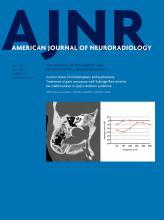Index by author
Vandertop, W.P.
- NeurointerventionYou have accessAneurysmal Parent Artery–Specific Inflow Conditions for Complete and Incomplete Circle of Willis ConfigurationsB.M.W. Cornelissen, J.J. Schneiders, M.E. Sprengers, R. van den Berg, P. van Ooij, A.J. Nederveen, E. van Bavel, W.P. Vandertop, C.H. Slump, H.A. Marquering and C.B.L.M. MajoieAmerican Journal of Neuroradiology May 2018, 39 (5) 910-915; DOI: https://doi.org/10.3174/ajnr.A5602
Verheij, E.
- Head and Neck ImagingYou have accessAnatomic Malformations of the Middle and Inner Ear in 22q11.2 Deletion Syndrome: Case Series and Literature ReviewE. Verheij, L. Elden, T.B. Crowley, F.A. Pameijer, E.H. Zackai, D.M. McDonald-McGinn and H.G.X.M. ThomeerAmerican Journal of Neuroradiology May 2018, 39 (5) 928-934; DOI: https://doi.org/10.3174/ajnr.A5588
Vos, J.A.
- FELLOWS' JOURNAL CLUBNeurointerventionYou have accessAccuracy of CT Angiography for Differentiating Pseudo-Occlusion from True Occlusion or High-Grade Stenosis of the Extracranial ICA in Acute Ischemic Stroke: A Retrospective MR CLEAN SubstudyM. Kappelhof, H.A. Marquering, O.A. Berkhemer, J. Borst, A. van der Lugt, W.H. van Zwam, J.A. Vos, G. Lycklama à Nijeholt, C.B.L.M. Majoie and B.J. Emmer on behalf of the MR CLEAN InvestigatorsAmerican Journal of Neuroradiology May 2018, 39 (5) 892-898; DOI: https://doi.org/10.3174/ajnr.A5601
All patients from the Multicenter Randomized Clinical Trial of Endovascular Treatment for Acute Ischemic Stroke in the Netherlands (MR CLEAN) with an apparent ICA occlusion on CTA and available DSA images were included. Two independent observers classified CTA images as atherosclerotic cause (occlusion/high-grade stenosis), dissection, or suspected pseudo-occlusion. Pseudo-occlusion was suspected if CTA showed a gradual contrast decline located above the level of the carotid bulb, especially in the presence of an occludedintracranial ICA bifurcation (T-occlusion). In 108 of 476 patients (23%), CTA showed an apparent extracranial carotid occlusion. DSA was available in 46 of these cases, showing an atherosclerotic cause in 13 (28%), dissection in 16 (35%), and pseudo-occlusion in 17 (37%). The sensitivity for detecting pseudo-occlusion on CTA was 82% for both observers. The authors conclude that on CTA, extracranial ICA pseudo-occlusions can be differentiated from true carotid occlusions.








